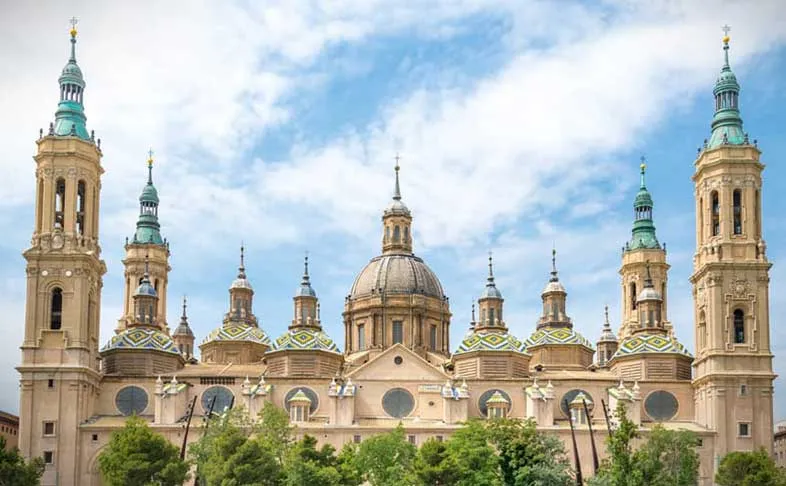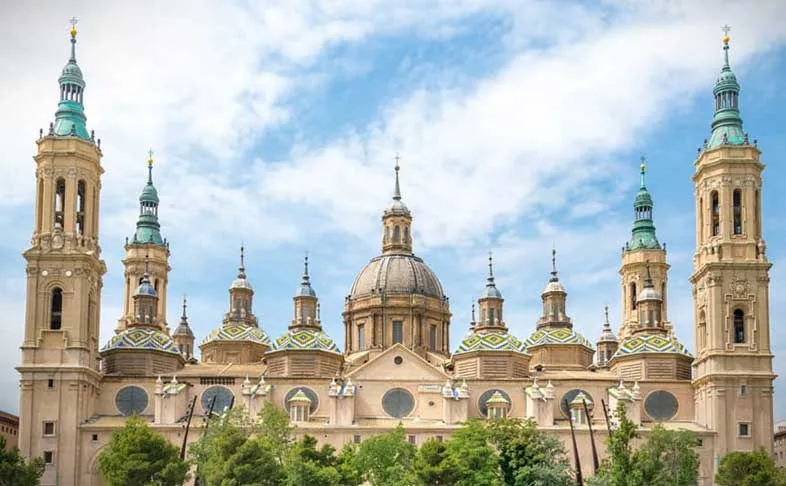
Introduction
The Cathedral-Basilica of Our Lady of the Pillar (Spanish: Catedral-Basílica de Nuestra Señora del Pilar) is a Roman Catholic church in the city of Zaragoza, Aragon (Spain). The basilica venerates Blessed Virgin Mary, under her title Our Lady of the Pillar praised as “Mother of the Hispanic Peoples” by Pope John Paul II. It is reputed to be the first church dedicated to Mary in history.
Local traditions take the history of this basilica to the spread of Christianity in Roman Spain attributing to an apparition to Saint James the Great, the apostle who is believed by tradition to have brought Christianity to the country. This is the only reported apparition of Mary to have occurred before her believed Assumption.
Many of the kings of Spain, many other foreign rulers and saints have paid their devotion before this statue of Mary. Saint John of the Cross, Saint Teresa of Ávila, Saint Ignatius of Loyola, and Blessed William Joseph Chaminade are among the foremost ones. The Basilica of Our Lady of the Pillar is one of two minor basilicas in the city of Zaragoza, and is co-cathedral of the city alongside the nearby La Seo de Zaragoza. The architecture is of Baroque style, and the present building was predominantly built between 1681 and 1872.
History - Apparition of Pilar
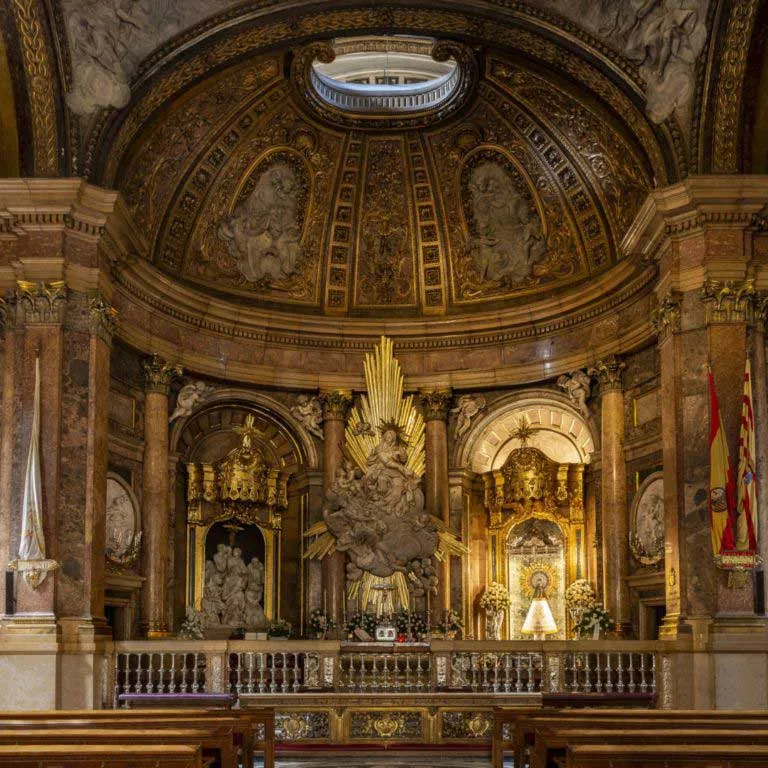
According to ancient local tradition, soon after the crucifixion and resurrection of Jesus, Saint James was preaching the Gospel in Spain, but was disheartened because of the failure of his mission. Tradition holds that on 2 January 40 AD, while he was deep in prayer by the banks of the Ebro, the Mother of God appeared to him and gave a column of jasper and instructed him to build a church in her honor: “This place is to be my house, and this image and column shall be the title and altar of the temple that you shall build” City of God.
First Chapel
About a year after the apparition, James is believed to have had a small chapel built in Mary’s honor, the first church ever dedicated to her. After James returned to Jerusalem, he was executed by Herod Agrippa in about 44 AD, the first apostle to be martyred for his faith. Several of his disciples took his body and returned it for final burial in Spain. This first chapel was eventually destroyed with various other Christian shrines, but the statue and the pillar stayed intact under the protection of the people of Zaragoza.
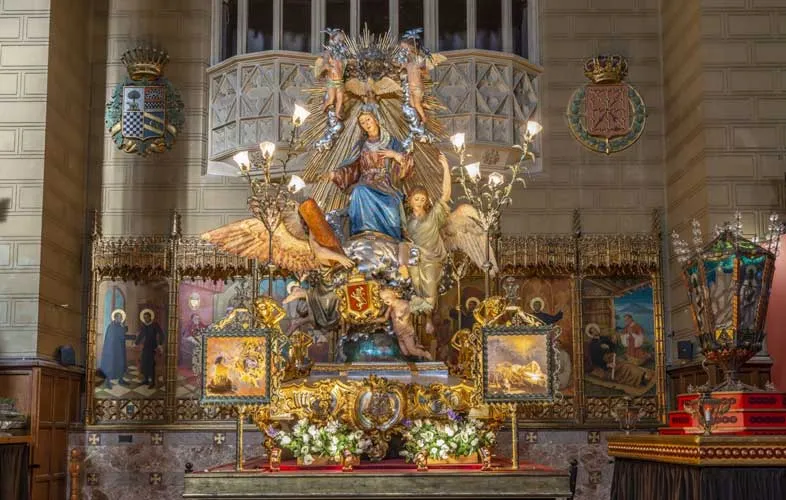
Expansions - Romanesque Church
Numerous churches have been built upon this site through the years. The tiny chapel built by Saint James later gave way to a basilicalike enclosure during Constantine I’s time; subsequently being transformed into Romanesque, then Gothic then Mudéjar styles. The venerated shrines at Zaragoza date to the Christian Reconquest by King Alfonso I in 1118. A church in the Romanesque style was built under the pontificate of Pedro de Librana who is also credited with the oldest written testimonial to the Virgin at Zaragoza. A tympanum on the south wall of this Romanesque church still stands.
Gothic Church
The Romanesque church was damaged by fire in 1434, and reconstruction began in the Mudéjar Gothic style. A Gothic-style church was built in the 15th century but only a few parts of it remain intact or were later restored, including the choir stand and the altarpiece in alabaster by Damián Forment.

Current Church
The present spacious church in Baroque style was begun in 1681 by Charles II, King of Spain and completed in 1686. The early constructions were supervised by Felipe Sanchez and were later modified by Francisco Herrera the Younger under John of Austria the Younger. In 1725, the Cabildo of Zaragoza decided to change the aspect of the Holy Chapel and commissioned the architect Ventura Rodríguez, who transformed the building into its present dimensions of 130 meters long by 67 wide, with its eleven cupolas and four towers.
The area most visited is the eastern part of the chapel, because this is where the Holy Chapel by Ventura Rodríguez (1754) is built, which houses the venerated image of the Virgin. Around the Holy Chapel are the vaults or domes painted with frescoes by Francisco Goya: The Queen of Martyrs and Adoration of the Name of God. The gilding and other ornamentation throughout the building were designed and overseen by Goya’s father José. By 1718 the church had been vaulted over. However, it was not until 1872 that the final touches were put to these vaults, when the main dome and the final spire were finished.
During the Spanish Civil War of 1936–1939 three bombs were dropped on the church but none of them exploded. Two of them are still on show in the basilica. Notable choirmasters include the Baroque composer Joseph Ruiz Samaniego.
Pillar and the Image
The statue is wooden and 39 cm tall and rests on a column of jasper. The tradition of the shrine of El Pilar, as given by Our Lady in an apparition to Sister Mary Agreda and written about in Mystical City of God, is that Our Lady was carried on a cloud by the angels to Zaragoza during the night. While they were traveling, the angels built a pillar of marble, and a miniature image of Our Lady.
Our Lady gave the message to St James and added that a church was to be built on the site where the apparition took place. The pillar and the image were to be part of the main altar. The image was crowned in 1905 with a crown designed by the Marquis of Griñi, and valued at 450,000 pesetas (£18,750, 1910).
Our Lady of the Pillar
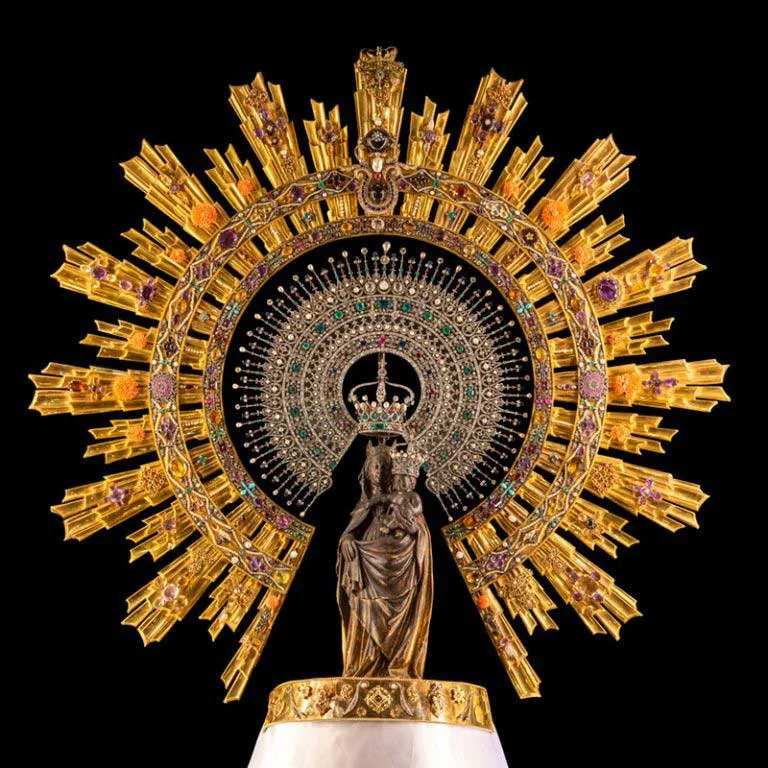
Our Lady of the Pillar (Spanish: Nuestra Señora del Pilar) is the name given to the Blessed Virgin Mary in the context of the traditional belief that Mary, while living in Jerusalem, supernaturally appeared to the Apostle James the Greater in AD 40 while he was preaching in what is now Spain. Those who adhere to this belief consider this appearance to be the only recorded instance of Mary exhibiting the mystical phenomenon of bilocation. Among Catholics, it is also considered the first Marian apparition, and unique because it happened while Mary was still living on Earth.
This title is also associated with a wooden image commemorating the apparition, which is now enshrined at the Cathedral-Basilica of Our Lady of the Pillar in Zaragoza, Aragon, Spain. Pope Callixtus III granted indulgences for visitors to the shrine in 1456. Pope Innocent XIII in 1730 mandated her veneration throughout the Spanish Empire. On 20 May 1905, Pope Pius X granted the image a canonical coronation.
Our Lady of the Pillar is considered the Patroness of Aragon and its capital Zaragoza, Hispanic people, the Hispanic world, and of the Spanish Civil Guard. Her feast day is 12 October, which coincides with Columbus Day, the national holiday of Spain.
History of Our Lady of the Pillar - Early Tradition
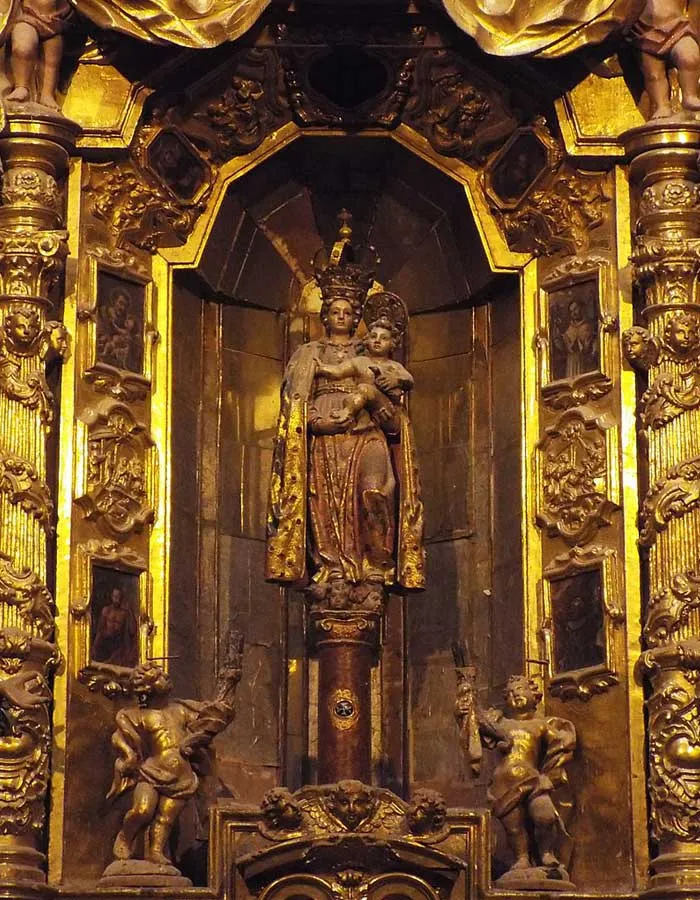
Catholic tradition holds that, in the early days of Christianity, the Apostles of Jesus spread the Gospel throughout the known world, with James the Greater evangelizing in Roman Hispania (modern-day Spain). He confronted great difficulties in his missionary efforts and faced severe discouragement. In AD 40, while he was praying by the banks of the Ebro at Caesaraugusta (Zaragoza), Mary bilocated from Jerusalem, where she was living at the time, and appeared to James, accompanied by thousands of angels, to console and encourage him.
Some of the earliest archaeological evidence of Marian devotion in Zaragoza is found in Christian tombs dating from Roman days, which appear to bear images representing the Assumption of the Blessed Virgin. In the 4th century, the presence of votive images placed on columns or pillars is attested.
The oldest written testimony of devotion to the Blessed Virgin in Zaragoza is usually identified as that of Pedro Librana in 1155. There is evidence that the site attracted pilgrims from across the Iberian Peninsula during the 13th century, e.g. reflected in the work Milagros de Nuestra Señora by Gonzalo de Berceo, dated to the 1250s or early 1260s. The appellation Santa María del Pilar is attested for 1299. The claim that the first church had been the oldest in Hispania, built in AD 40 by James the Greater, is first recorded in 1318.
A book by Michael O’Neil (2015) called Exploring the Miraculous indicates that there are various traditions about earliest approvals by the church of this marian apparition. From his book: “For example, one of the great pilgrimage sites in Spain, Our Lady of the Pillar in Zaragoza, originating in a miracle and housing an ancient jasper Marian image on a column, did not always recognize Our Lady under this title.
According to the legend relating to the apostle St. James the Greater and his travels in Spain, on January 2 in the year 40, he was disheartened with his lack of success in proclaiming the gospel in Caesaraugusta (present-day Zaragoza) by the river Ebro, when he saw Mary (still alive at the time) miraculously appear on a pillar, comforting him and calling him to return to Jerusalem.
The first written mention of the Virgin of Zaragoza comes from a bishop in the middle of the twelfth century, and Zaragoza’s co-cathedral’s name did not originally include a reference to El Pilar, being called Santa Maria Mayor. In 1296, Pope Boniface VIII conferred an indulgence on pilgrims visiting this shrine but still without mention of Our Lady of the Pillar. One of the legal councils of Zaragoza first wrote about Our Lady under this title in 1299, promising safety and privileges to pilgrims who came to visit the shrine.
In 1456, Pope Calixtus III issued a bull encouraging pilgrimage to Our Lady of the Pillar and confirming the name and the miraculous origin. So, despite the lack of early extant texts about the miracle story and the name of this devotion, the enduring tradition delivers the story to us today.” In other interpretations, the tradition of the Marian apparition can be traced to the 15th century: In either 1434 or 1435, a fire destroyed the alabaster altarpiece. The replacement altarpiece features bas-relief representations of the Marian apparition. The image of the Virgen del Pilar venerated today also dates to this period. It executed in the late Gothic style of Juan de la Huerta.
Pope Calixtus III in a bull issued on 23 September 1456 declares a seven-year indulgence for those who visit Our Lady of Saragossa. The text of the bull specifically mentions a pillar, for the first time suggesting the existence of an image known as Our Lady of the Pillar. The feast day of 12 October was officially introduced by the Council of Zaragoza in 1640.
According to the account by María de Ágreda (d. 1665) in her Mystical City of God, Mary, mother of Jesus, was transported from Jerusalem to Hispania during the night, on a cloud carried by angels. During the journey, the angels also built a pillar of marble, and a miniature image of Mary with the Child Jesus.

Marian Apparition Approval
The Apparition of Our Lady of the Pillar was accepted as canonical by Pope Innocent XIII in 1723. So many contradictions[clarification needed] had arisen concerning the miraculous origin of the church that Spain appealed to Innocent XIII to settle the controversy. After careful investigation, the twelve cardinals, in whose hands the affair rested, adopted the following account, which was approved by the Sacred Congregation of Rites on 7 August 1723, and later inserted in the lessons of the office of the feast of our Lady of the Pillar, celebrated on 12 October:
Of all the places that Spain offers for the veneration of the devout, the most illustrious is doubtless the sanctuary consecrated to God under the invocation of the Blessed Virgin, under the title of our Lady of the Pillar, at Saragossa. According to ancient and pious tradition, St. James the Greater, led by Providence into Spain, spent some time at Saragossa. He there received a signal favour from the Blessed Virgin. As he was praying with his disciples one night, upon the banks of the Ebro, as the same tradition informs us, the Mother of God, who still lived, appeared to him, and commanded him to erect an oratory in that place.
The apostle delayed not to obey this injunction, and with the assistance of his disciples soon constructed a small chapel. In the course of time a larger church was built and dedicated, which, with the dedication of Saint Saviour’s, is kept as a festival in the city and Diocese of Saragossa on the 4th of October.
James returned to Jerusalem with some of his disciples where he became a martyr, beheaded in AD 44 during the reign of Herod Agrippa. His disciples allegedly returned his body to Spain. The year AD 40 is the earliest recognised Marian apparition in the Catholic Church, dating to a time when Mary, the mother of Jesus, was still alive.
Pope Clement XII allowed the celebration of the feast of Our Lady of the Pillar all over the Spanish Empire in 1730. Since the feast day (12 October) coincides with the discovery of the Americas (12 October 1492), Mary was later named as Patroness of the Hispanic World under this title.

Layout
The building, which can be seen from the nearby Ebro River, is a large rectangle with a nave and two aisles, with two other all-brick chapels, thus giving the whole a typically Aragonese touch. It is illuminated by large oculi, characteristic of the monuments of the region from the 17th century onwards. Twelve enormous pillars support the vaults of the nave and aisles; the whole is topped by domes, as are the chapels.
The Chapels within the Basilica include:
- Chapel of the Rosary
- Chapel of Joachim
- Chapel of Saint Lawrence (Lorenzo)
- Chapel of Saint Pedro de Arbués
- Chapel of Saint Braulio
- Chapel of Saint Anthony
- Chapel of Saint Joseph
- Chapel of Saint Anna
- Chapel of Saint John
Organ and Music
The first organ was built in 1463 by Enrique de Colonia. In 1537, Martín de Córdoba built another organ with the intent to compete with the one at the La Seo. Guillermo de Lupe and his son Gaudioso restructured the larger organ between 1595 and 1602; he had done the same for an organ in the Cathedral of the Savior of Zaragoza in 1577.
In 1657, there were several organs in the church, of many sizes and offering many possibilities. As a result, the musical activity reached a peak in the Spanish Golden Age; however, it began to decline toward the end of the 19th century.
In the Middle Ages, a minstrel accompanied singers with a dulcian. Polyphony in the Cathedral-Basilica of Our Lady of the Pillar was first documented in the mid-17th century, played by a “tenor” and a “contrabajón”. In the late 1600s, an orchestra composed of minstrels agreed to work for the Church of Santa María la Mayor, the predecessor of the cathedral-basilica.
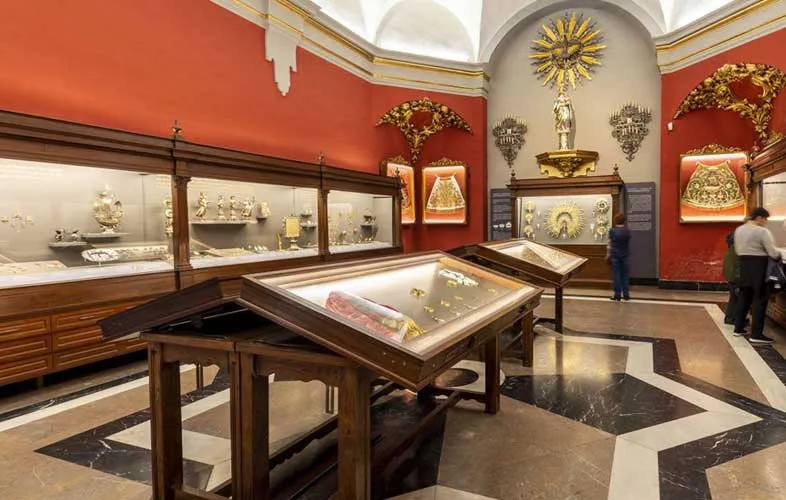
El Pilar and Spanish Identity
The feast of Our Lady of the Pillar, celebrating the first apparition of Mary to Hispanic people, is on October 12. This coincides with the Día de la Hispanidad and the date of Columbus’s discovery of the New World.
Every nation of Hispanic colonial origin has donated national vestments for the fifteenth-century statue of the Virgin, which is housed in the chapel. Pope John Paul II praised El Pilar as “Mother of the Hispanic Peoples” during both his visits to the basilica. It was declared Bien de Interés Cultural in 1904.
Other Depictions
Our Lady of the Pillar is a common motif of the Madonna and Child in Spanish art; extant examples other than the Saragossa image date from the Renaissance period onward. Depictions become especially numerous following the introduction of the feast day throughout the Spanish Empire in 1730.
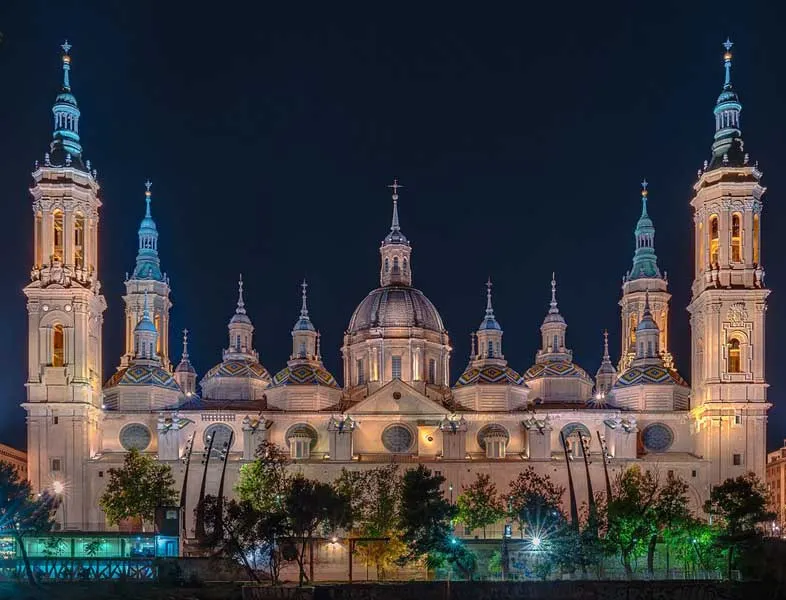
Feast Day - 12th October
The Annual Feast Day of Our Lady of the Pillar is celebrated on 12 October and she is the Patroness of the Hispanic peoples and the Spanish Civil Guard. A grand nine-day festival known as Fiestas del Pilar is celebrated in Saragossa (Zaragoza) every year in her honour.
The modern Fiestas del Pilar, as they developed since the 19th century, begin on the weekend preceding 12 October and they end on the Sunday after 12 October (i.e. they move between 5–13 and 11–19 October). They were declared as a “national holiday of touristic interest” (Fiesta de Interés Turístico Nacional) by the Ministerio de Comercio y Turismo in 1980.
Mass Time
Every days
Saturdays
Sundays
Church Visiting Time
Contact Info
Plaza del Pilar, s/n, 50003,
Zaragoza, Aragon, Spain.
Phone No.
Tel : +34 976 39 74 97
Accommodations
How to reach the Cathedral Basilica
Zaragoza International Airport near Zaragoza, Aragón, Spain is the nearby Airport to the Cathedral Basilica.
Plaza del Pilar-Murallas Tram Stop in Zaragoza, Spain is the nearby Tram Station to the Cathedral Basilica.

